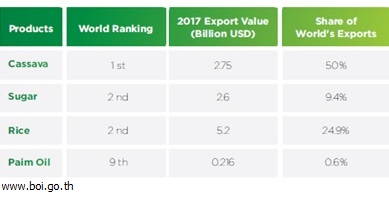Challenges

** Dr. Suvit Maesincee, "BCG Model: Sustainable Economic Model"

** Dr. Suvit Maesincee, "BCG Model: Sustainable Economic Model"
Thailand’s Competitive Advantage in Bioeconomy
Fundamental concept of bioeconomy is the value creation of resources. As Thailand is blessed with robust agricultural activities, rich natural resources, and diversity in term of both biological resources and physical geography, the country is in an excellent position to take on bioeconomy.


Thailand is among top producers and exporters of several agricultural commodities and aquacultures such as rice, cassava, sugarcane, para rubber and shrimp. Some of these crops are of significant importance to both food and energy security. In addition to strong biomass production sector, food industry and other related industry in the value chain also represent a large industrial sector in Thailand. The food industry contributed approximately 23% of the country’s GDP and the value of Thailand’s food industry, including local consumption and exports, is expected to reach USD102 billion in 2017.
Thailand is situated in "Indo-Burma" – a biodiversity hotspot that is ranked as the eighth most bio-diverse region in the world. Hosting several forest types and aquatic habitats, Thailand is estimated to support about 10% of all species of living organisms in the world. Significant investment has been made to support biodiversity research and establish world-class infrastructure for preserving microorganisms with the purpose of utilization study, making the country No. 6 in the world in term of microbial collection.
In November 2019, Thailand’s Ministry of Higher Education, Science, Research and Innovation (MHESI) unveiled a proposal entitled “BCG in Action: The New Sustainable Growth Engine” mapping out strategies to drive BCG agenda forward.
Blessed with rich natural resources and strong agricultural activities, Thailand will apply the BCG model to focus on four s-curve industries - namely agriculture and food; bioenergy, biomaterial and biochemical; medical and wellness; and tourism and creative economy. Science, technology and innovation have enormous roles to play in this BCG movement. Innovations can be employed to enhance the capacity and competitiveness of players across the value chain, both upstream and downstream, in all four s-curve industries.
With proper agricultural innovations, farm productivity and efficiency can be raised, benefiting the whole bioeconomy as biomass is the foundation of all industries in the bioeconomy model. Farm production improvement also boosts income of farmers and communities, and thereby reducing social disparity.
Innovative technology can be applied to add value to resources and agricultural products, and thereby enhancing the competitiveness of downstream industries. High-value products for the agriculture and food industry could be, for examples, functional food ingredients; for health and medicine industry are biopharmaceuticals and precision medicine treatment; for energy and chemicals industry are valorized fuels and chemicals, and for tourism industry a medical or knowledge-based tourism.
The four target industries currently have a combined economic value of 3.4 trillion THB (21% of GDP). BCG model has a potential to increase the economic value to 4.4 trillion THB (24% of GDP) in the next five years.
BCG strategy consists of 4 drivers and 4 enablers, involving close collaborations among the government, industry, communities, academia and international organizations.

111 Thailand Science Park
Phahonyothin Road, Khlong Nueng, Khlong Luang,
Pathum Thani 12120
THAILAND
Tel: +66 (0) 2-564-7000
Fax: +66 (0) 2-564-7001 to 5

Over several decades, Thailand has progressed through three economic development phases. In the first phase, Thailand 1.0 emphasis was placed on the agricultural sector. Then came Thailand 2.0 with the focus on light industries, enabling the nation to upgrade from a low-income to middle-income economy. In the third phase, Thailand 3.0, the focus was shifted to heavy industries to sustain economic growth. During this period, however, Thailand’s economic growth became stagnant, facing the situation of “middle-income-trap” syndrome, while the country was also confronted with disparities and imbalanced development.

** http://c-asean.org/index.php
To cope with these challenges, Thailand 4.0 policy was introduced. Thailand 4.0 aims to transform the current economy to one that is much more innovation-driven – shifting from traditional farming to smart farming, from SMEs to startups, from labor to knowledge workforce and from importing technologies to inventing innovative solutions.